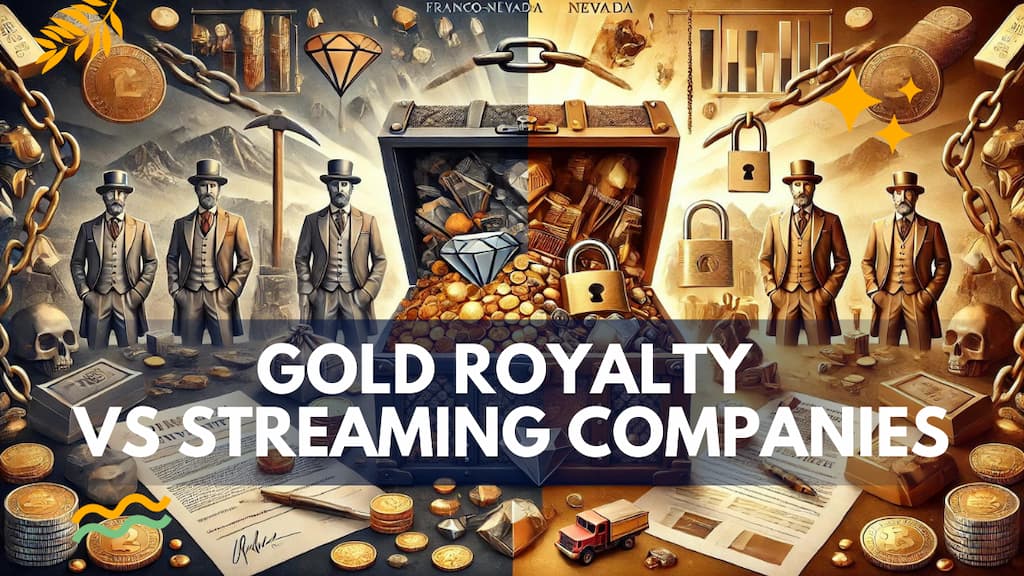Want to put money into gold without running a mine? Gold royalty and streaming companies give a one-of-a-kind way to be part of precious metals.
These firms bring lower risks and possible higher returns compared to old-fashioned mining stocks. This guide clarifies how they work, their pluses, and plans for adding them to your portfolio to make it more diverse beyond normal investments.
Find out an innovative way to grow your wealth through the changing world of gold royalties and streaming.
Understanding Gold Royalty and Streaming Companies
Gold royalty and streaming companies work in a part of the precious metals industry that’s often overlooked, yet offers a unique chance for investors. To understand these companies, you need to grasp their main business models and how they’re different from regular mining companies.
The Basics of Royalty Companies
Royalty companies give money upfront to mining companies in exchange for a percentage of future gold production or revenue. This deal, called a royalty agreement, usually lasts for the entire life of the mine.
The two main types of royalties are Net Smelter Return (NSR) and Gross Revenue Royalty (GRR).
A royalty company’s income is directly linked to the mine’s production and gold prices.
When gold prices go up, their income increases. When gold prices fall, their income decreases.
This direct link makes royalty companies attractive for investors who want exposure to gold prices without the risks of running a traditional mining company.
Royalty companies have been around in the mining sector since the 1980s. They became an important alternative way to finance mining, especially when traditional funding was hard to get.
This history is important because it shows how tough and adaptable the royalty model is through different market cycles.
Streaming Companies Explained
Streaming companies work similarly to royalty companies but with one key difference. Instead of getting a percentage of revenue, streaming companies buy a fixed amount of a mine’s production at a set price, which is usually much lower than the market price.
For example, a streaming company might agree to buy 20% of a mine’s gold production for $400 per ounce. If gold is selling for $1,800 per ounce, the streaming company can make a big profit on each ounce sold.
This setup helps both sides: the mining company gets money upfront for development or expansion, while the streaming company gets access to potentially cheap gold for a long time.
Streaming deals are set up to provide a fixed price for the metal, which can be a big advantage when gold prices are rising.
However, this setup also means that streaming companies are at risk if gold prices fall. If gold prices drop, their profits may decrease.
Key Differences: Royalties vs. Streaming
While royalty and streaming companies might look similar, there are important differences that investors should think about:
Royalty companies get a percentage of revenue, directly tying their income to how well the mine does and gold prices. Streaming companies buy gold at a fixed price and profit from the difference when selling at market rates, potentially leading to higher returns during periods of bullish gold market conditions.
Royalty companies have very little involvement in actual mining operations, which greatly reduces their exposure to operational risks and costs. Streaming companies also have limited involvement in mining operations, but their fixed-price agreements can expose them to gold price risks.
The Revenue Generation Process
Understanding how these companies make money is crucial for assessing them as potential investments:
Royalty companies receive a percentage of revenue from the mine’s production. This revenue is directly tied to gold prices, so when gold prices rise, their revenue increases.
Streaming companies acquire precious metal at predetermined rates and sell it at current market prices. Their revenue is also tied to gold prices, but their pre-arranged purchase terms can provide some protection against gold price changes.
In both cases, the way they make money is relatively straightforward. However, the key difference is in how exposed they are to gold price risks.
Royalty companies are directly exposed to gold price changes, while streaming companies have a fixed-price agreement that can provide some protection.
Profit Margins and Cost Structure
One of the most attractive aspects of gold royalty and streaming companies for investors is their potential for high profit margins and lean cost structure:
Royalty companies have very low overhead costs, which means that a big portion of their revenue goes straight to profit. This lean structure allows them to stay profitable even when gold prices are lower.
Streaming companies also have low operational costs, but their agreements to purchase at preset prices can make them susceptible to gold market fluctuations. However, this structure also means that they can potentially see amplified profits during bullish gold markets.
In both cases, the key to success is keeping operational costs low and generating significant revenue from gold sales. By doing this, these companies can offer investors a unique opportunity to gain exposure to the gold market without the operational risks associated with traditional mining companies.
Major Players in the Gold Royalty and Streaming Sector
Companies specializing in gold-based financial agreements have become more and more popular among investors seeking to tap into the precious metal market without the burden of mine management. You’ll find that these companies offer a unique value, providing a way to participate in the gold market while lowering the risks that come with mining operations.
Top Royalty Companies
Franco-Nevada Corporation is one of the biggest and most successful gold royalty companies. Started in 2007, Franco-Nevada has built a varied portfolio of royalties and streams, focusing on gold, silver, and other precious metals.
The company’s business model is designed to provide a steady flow of revenue, while lowering the risks linked to mining operations.
One of Franco-Nevada’s key strengths is its spread across different countries.
The company has royalties and streams on mines located in some of the most stable and mining-friendly countries in the world, including Canada, the United States, and Australia.
This spread helps to lower the risks linked to any one particular mine or country.
In terms of recent financial performance, Franco-Nevada has reported strong revenue growth, driven by rising gold prices and the addition of new royalties and streams to its portfolio. The company’s growth plan is focused on continuing to expand its diverse collection of mining agreements, while also exploring new opportunities in the gold and precious metals sector.
Royal Gold is another major player in the gold royalty sector. At its core, the company operates by acquiring and overseeing royalties on gold and other precious metals mines.
Royal Gold boasts a diverse array of revenue streams from mining operations, with a focus on mines located in North America.
One of Royal Gold’s key advantages is its ability to offer financial support to mining operations in return for royalty agreements. This allows the company to secure royalties on high-quality mines, while also providing a source of funding for mining companies.
Royal Gold has a strong track record of giving returns to shareholders, with a history of paying steady dividends. The company’s dividend policy is focused on returning a big portion of its cash flow to shareholders, while also keeping enough capital to fund its growth initiatives.
Leading Streaming Companies
Wheaton Precious Metals is one of the largest and most successful gold streaming companies. The firm’s core strategy revolves around acquiring streams from operations extracting gold and other valuable metals, in exchange for an upfront payment and ongoing payments based on the amount of metal produced.
Wheaton Precious Metals has a varied portfolio of streams, primarily concentrated in mining operations across the Americas. The company’s strategy centers on continuously enlarging its collection of streams, while also seeking out fresh ventures in the domain of precious minerals and rare earth elements.
One of Wheaton Precious Metals’ key strengths is its ability to provide capital infusions to mining ventures in exchange for a share of future metal yields. This strategy enables the company to gain access to streams from premium mining assets, while also offering a financial lifeline to mining operations.
Sandstorm Gold stands out as a key contender in the gold streaming sector. The company’s primary focus lies in acquiring gold stream agreements, with an emphasis on mining operations across North and South America.
Sandstorm Gold has a specific focus on smaller, high-grade gold mines, which enables the company to acquire rights to high-quality assets at favorable terms. The firm’s core approach revolves around enlarging its stream portfolio and uncovering promising ventures in the precious metals landscape.
In terms of risk management, Sandstorm Gold has demonstrated consistent excellence in managing its financial risk, with a focus on keeping a strong balance sheet and lowering its exposure to changes in commodity prices. The company’s financial stability is bolstered by its varied portfolio of streams, which generates a consistent and reliable income stream.
Advantages and Disadvantages of Investing in Gold Royalty and Streaming Companies
When thinking about investing in these specialized precious metal financing entities, it’s important to understand both the potential benefits and the risks involved.
These unique players in the gold sector offer investors an alternative approach to precious metal investment. By providing royalties and streaming agreements, they create a different way for individuals to gain exposure to gold without directly owning mines or physical bullion.
Advantages
Putting money into gold-focused financial instruments offers several advantages.
One of the biggest benefits is lower operational risks. These companies don’t have to deal with day-to-day mine management, equipment upkeep, or worker issues.
This business model protects investors from rising costs in mining operations, which can really cut into profits for regular mining companies.
Another advantage is better exposure to rising gold prices.
Firms specializing in precious metal agreements often give higher returns during gold bull markets. As gold prices go up, these companies can see their revenues increase a lot without a matching increase in costs.
This unique position allows investors to potentially benefit from both rising gold prices and more production at the mines they’re invested in, without needing to spend more money.
The strong financial position and cash flows of firms specializing in precious metal financing agreements are also attractive features.
Many of these companies have strong balance sheets with very little debt. This financial strength comes from their business model, which typically generates steady cash flows across different market conditions.
The ability to fund new deals and grow their portfolio on their own, even during tough market times, is a big advantage for these companies and their investors.
Investors looking for income might also like precious metal finance firms because of their potential for dividends and shareholder returns.
The sector has shown a history of dividend growth, with some companies regularly increasing their payouts over time.
Also, the strong cash flow of these businesses can sometimes lead to share buybacks or special dividends, further boosting shareholder returns.
Finally, the built-in diversification of companies focused on gold and silver funding deals can help lower the risk associated with any single mine or region.
By investing in multiple mining operations across various locations, these companies spread out the risk. If some mines don’t make as much money as expected, others can still produce income, which helps smooth out the performance of their overall portfolio.
Disadvantages
Despite the advantages, investing in gold-centric financial products also has several disadvantages.
One of the main risks is depending on mining partners. Problems with operations, delays in production, or poor performance at partner mines can directly impact the income of these companies.
This reliance on third-party operators brings a level of risk that investors need to think about.
Another disadvantage is sensitivity to gold prices. While higher exposure to gold prices can be good during bull markets, it also means these companies are particularly vulnerable when gold prices fall.
Changes in revenue tied to gold price movements can be more noticeable for royalty and streaming companies compared to physical gold holdings or even some regular mining stocks.
Investors need to be ready for potentially big share price changes in response to changes in the gold market.
Political and regulatory risks are also a concern for precious metal financing firms.
Changes in mining rules, taxes, or environmental policies in different countries can impact how profitable their agreements are.
Political instability in certain mining regions can also cause problems, potentially affecting the operations of partner mines and, as a result, the income of royalty and streaming companies.
Valuation and growth challenges are additional things to consider. Because of their attractive business model, precious metal financing firms often trade at higher prices compared to regular mining stocks.
This can make it hard for investors to find good times to buy in. Also, as the sector has become more competitive, getting new high-quality royalty or streaming deals has become increasingly difficult.
This competition could potentially impact the future growth of companies in this space.
Finally, those who put their money into precious metal financing arrangements have no direct control over the mining operations that generate their income.
Decisions about production levels, mine development, or exploration activities are made by the operating partners.
This lack of operational control can be frustrating for investors, especially if they disagree with the strategies used by the mining companies.
Performance Analysis: Gold Royalty/Streaming vs. Other Investments
When looking at investment options, you need to think about how precious metal financing firms compare to other choices. These companies offer a unique way to invest in gold, but they perform differently from traditional gold investments.
Comparison with Traditional Gold Investments
Precious metal financing firms often do better than traditional gold investments during bullish market conditions for gold. This is because they can boost returns without extra operating costs.
However, when gold prices are falling, they may do worse than physical gold or gold ETFs.
This is important to think about when deciding if they should be part of your investment mix.
In terms of up and down swings, these companies are in the middle. They usually have fewer big swings than pure mining stocks but experience more volatility compared to bullion or gold-backed funds.
This steadier performance comes from their spread-out portfolio of agreements across many mining operations and regions, which helps lower the risks of relying on just one mine.
Correlation with Broader Market and Tech Sector
One of the best features of precious metal financing stocks is how they can help balance your investment mix. They usually don’t move in the same way as broad market indexes like the S&P 500 and NASDAQ, making them useful for lowering overall investment risk.
This difference in movement becomes really valuable during market downturns. Past data shows that during big market drops, several precious metal financing enterprises have held up well, sometimes even making money while broader market indexes were losing value.
Long-term Growth Trends
Looking at the long-term performance of precious metal financing firms shows that some have grown a lot.
For example, Sandstorm Gold grew by nearly 700% from 2009 to 2013, showing how much these companies can grow.
Also, companies like Gold Royalty Corp. expect big growth, with Gold Royalty thinking their revenue will double in 2024 thanks to key royalties starting to make money.
This growth can happen because of several things:
- They benefit from rising gold prices without their costs going up as much
- They can gain from their mining partners finding more gold without spending extra money themselves
- They use the money they make to buy new agreements, which helps them grow even more over time
Looking ahead, the future looks good for gold-focused financial backers. Mining companies still need different ways to get money, and gold prices might keep going up, which suggests these companies could keep growing.
It’s important to remember that just because something did well in the past doesn’t mean it will keep doing well.
The industry faces challenges, like more companies trying to get good royalty and streaming deals, which could affect how much they grow in the future.
Also, if gold prices stay low for a long time, it could really hurt how well these companies do.
How to Invest in Gold Royalty and Streaming Companies
When looking at precious metal royalty and streaming enterprises, you must consider key financial measures that show their health and growth potential. Revenue growth, profit margins, and cash flow generation are vital factors to check.
Direct Stock Investment Strategies
To invest directly in precious metal financing firms, focus on companies with steady year-over-year revenue growth, operating margins above 60%, and strong free cash flow yields. These measures give insight into a company’s ability to make consistent returns and fund new purchases.
Careful research on a company’s assortment of mining agreements and revenue-sharing contracts is essential.
Check the quality of the underlying mining operations, their spread across different locations, and the potential for growth or new discoveries.
Companies with diverse portfolios spread across stable mining areas typically offer lower risk profiles.
Timing investments in this up-and-down industry can be tricky.
A dollar-cost averaging approach, where you regularly invest smaller amounts over time, can help reduce the impact of market swings.
This strategy is particularly useful in the precious metals sector, which is known for its price changes.
ETFs and Mutual Funds Focused on Royalty/Streaming
For investors looking for broader exposure to the gold royalty and streaming sector, exchange-traded funds (ETFs) and mutual funds offer an alternative to picking individual stocks. These funds typically hold a varied portfolio of companies, providing instant variety and professional management.
When evaluating funds, compare expense ratios and performance track records. Funds with a history of steady returns and low fees are generally better.
Some ETFs in this sector have competitive expense ratios, making them an attractive option for cost-conscious investors.
Integrating Royalty/Streaming Investments in a Diversified Portfolio
Adding gold royalty and streaming investments into a varied portfolio requires careful thought about risk tolerance and overall investment goals. For most investors, these investments should be a portion of the overall portfolio, with the exact amount depending on individual circumstances and market conditions.
Balancing royalty and streaming investments with other precious metal exposures, such as physical gold or traditional mining stocks, can provide exposure to different aspects of the gold market while managing risk. While royalty companies offer lower operational risk, they may provide less leverage to rising gold prices compared to mining stocks.
Regular portfolio rebalancing is essential to maintain the desired mix.
As the value of royalty and streaming investments changes with gold prices and company performance, periodic adjustments may be necessary to maintain the target mix.
Annual rebalancing or adjustments when allocations drift significantly from their targets are common practices.
Investors should be aware of the unique features of gold-focused financial instruments when adding them to a portfolio.
These specialized investment vehicles often provide a hedge against inflation and economic uncertainty, similar to gold itself. However, they also offer the potential for dividend income and capital growth, which can boost overall portfolio returns.
Staying informed about market trends and rule changes that may impact the sector is crucial.
The gold royalty and streaming industry is changing, with new players entering the market and existing companies growing their portfolios.
Keeping up with these developments can help inform investment decisions and portfolio adjustments over time.
Closing Thoughts
Gold royalty and streaming companies give you a way to put money into precious metals with less risk than owning mines. These firms can bring high returns and steady income, but watch out for changes in gold prices.
Want to start? Look at big names like Franco-Nevada and Wheaton Precious Metals. Or try ETFs if you want a mix of companies to invest in.
Put some cash here based on how much risk you’re okay with taking. Keep learning about this market and how these companies are doing. Then you can make smart choices about where to invest your money for the best results.











